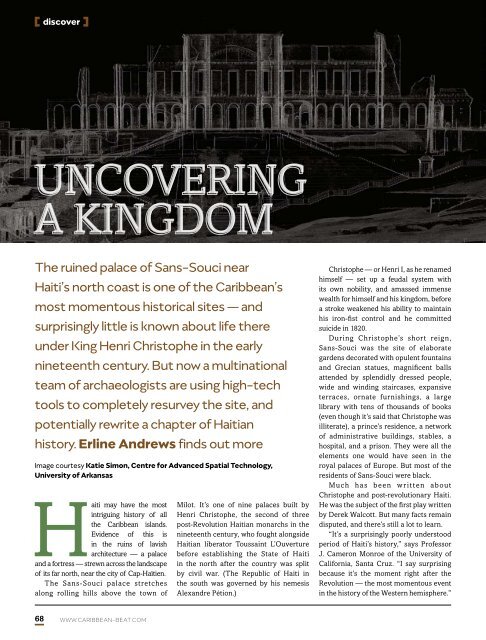Caribbean Beat — May/June 2018 (#151)
A calendar of events; music, film, and book reviews; travel features; people profiles, and much more.
A calendar of events; music, film, and book reviews; travel features; people profiles, and much more.
You also want an ePaper? Increase the reach of your titles
YUMPU automatically turns print PDFs into web optimized ePapers that Google loves.
discover<br />
Uncovering<br />
a kingdom<br />
The ruined palace of Sans-Souci near<br />
Haiti’s north coast is one of the <strong>Caribbean</strong>’s<br />
most momentous historical sites <strong>—</strong> and<br />
surprisingly little is known about life there<br />
under King Henri Christophe in the early<br />
nineteenth century. But now a multinational<br />
team of archaeologists are using high-tech<br />
tools to completely resurvey the site, and<br />
potentially rewrite a chapter of Haitian<br />
history. Erline Andrews finds out more<br />
Image courtesy Katie Simon, Centre for Advanced Spatial Technology,<br />
University of Arkansas<br />
Haiti may have the most<br />
intriguing history of all<br />
the <strong>Caribbean</strong> islands.<br />
Evidence of this is<br />
in the ruins of lavish<br />
architecture <strong>—</strong> a palace<br />
and a fortress <strong>—</strong> strewn across the landscape<br />
of its far north, near the city of Cap-Haïtien.<br />
The Sans-Souci palace stretches<br />
along rolling hills above the town of<br />
Milot. It’s one of nine palaces built by<br />
Henri Christophe, the second of three<br />
post-Revolution Haitian monarchs in the<br />
nineteenth century, who fought alongside<br />
Haitian liberator Toussaint L’Ouverture<br />
before establishing the State of Haiti<br />
in the north after the country was split<br />
by civil war. (The Republic of Haiti in<br />
the south was governed by his nemesis<br />
Alexandre Pétion.)<br />
Christophe <strong>—</strong> or Henri I, as he renamed<br />
himself <strong>—</strong> set up a feudal system with<br />
its own nobility, and amassed immense<br />
wealth for himself and his kingdom, before<br />
a stroke weakened his ability to maintain<br />
his iron-fist control and he committed<br />
suicide in 1820.<br />
During Christophe’s short reign,<br />
Sans-Souci was the site of elaborate<br />
gardens decorated with opulent fountains<br />
and Grecian statues, magnificent balls<br />
attended by splendidly dressed people,<br />
wide and winding staircases, expansive<br />
terraces, ornate furnishings, a large<br />
library with tens of thousands of books<br />
(even though it’s said that Christophe was<br />
illiterate), a prince’s residence, a network<br />
of administrative buildings, stables, a<br />
hospital, and a prison. They were all the<br />
elements one would have seen in the<br />
royal palaces of Europe. But most of the<br />
residents of Sans-Souci were black.<br />
Much has been written about<br />
Christophe and post-revolutionary Haiti.<br />
He was the subject of the first play written<br />
by Derek Walcott. But many facts remain<br />
disputed, and there’s still a lot to learn.<br />
“It’s a surprisingly poorly understood<br />
period of Haiti’s history,” says Professor<br />
J. Cameron Monroe of the University of<br />
California, Santa Cruz. “I say surprising<br />
because it’s the moment right after the<br />
Revolution <strong>—</strong> the most momentous event<br />
in the history of the Western hemisphere.”<br />
68 WWW.CARIBBEAN-BEAT.COM


















